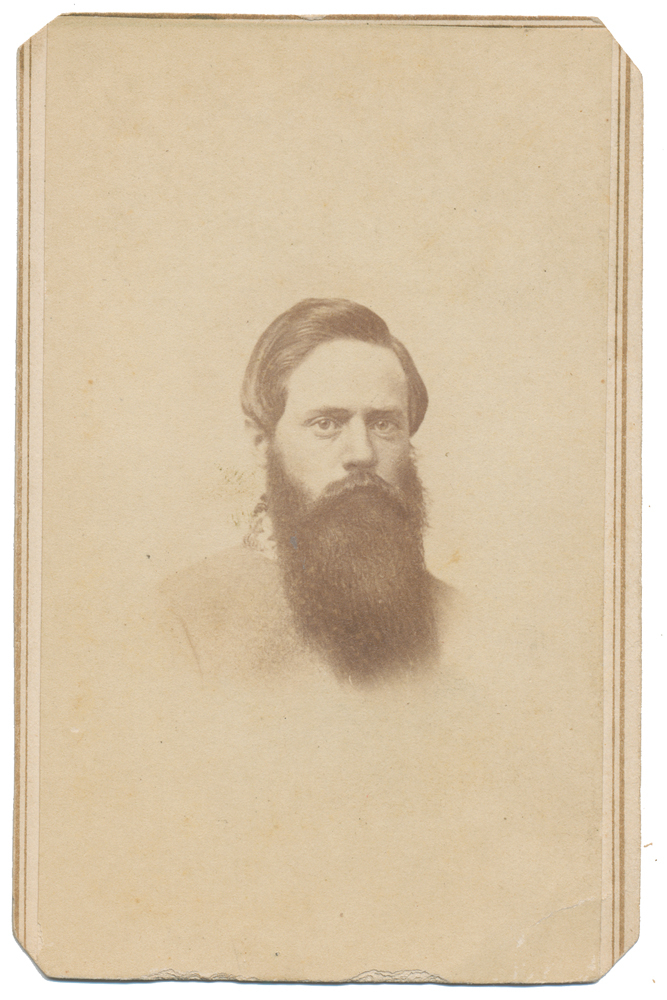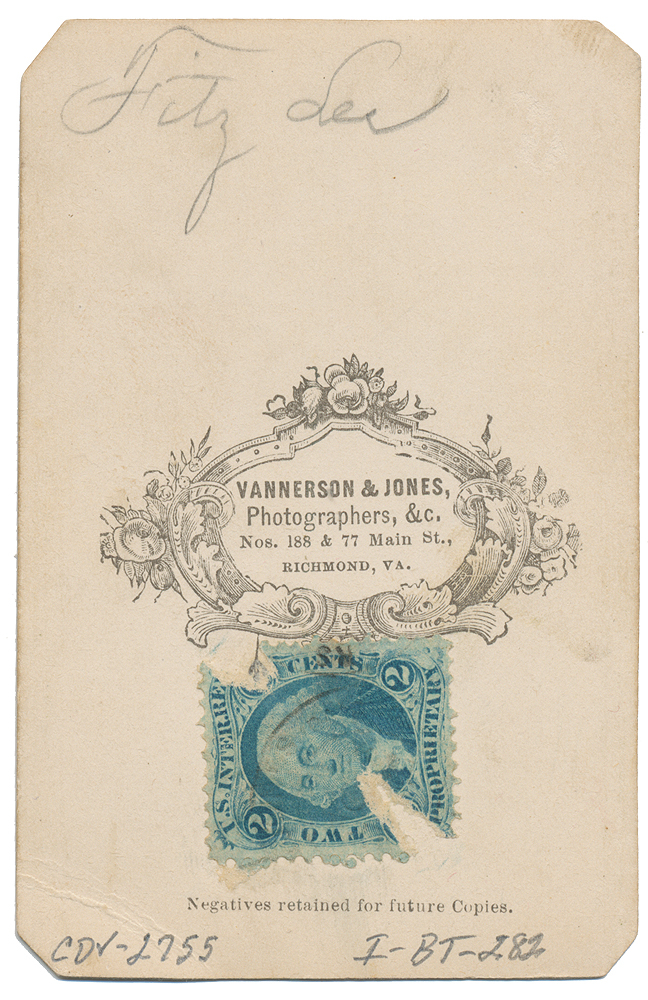site search
online catalog
BUST IMAGE OF GENERAL FITZHUGH LEE

Hover to zoom


$400.00 SOLD
Quantity Available: None
Item Code: 1138-283
Image shows Lee in Confederate uniform and sporting his signature long beard.
Image has good clarity and contrast. Paper and mount are good. Mount corners have been slightly clipped.
Reverse has a photographer’s imprint for VANNERSON & JONES… RICHMOND, VA. Top has an old pencil ID of “FITZ LEE.” Reverse also has a green 2 cent tax stamp and some collector information in pencil at bottom.
From the collection of the late William A. Turner.
Fitzhugh Lee was born at Clermont, Fairfax County, Va., November 19, 1835. He is the son of Sydney Smith Lee, who was a brother of Robert E. Lee, and son of Gen. and Gov. Henry Lee.
Fitzhugh Lee was graduated at the United States military academy in 1856, and after serving until January 1, 1858, in the cavalry school at Carlisle, Pa., as an instructor, he was assigned to frontier duty in Texas with his regiment, the Second cavalry.
He served at several Texas posts, and on May 13, 1859, in a fight with Comanche Indians was shot through the lungs with an arrow, and his life despaired of. In 1860 he was ordered to report to West Point as instructor of cavalry.
In 1861 he resigned his commission as first lieutenant, and tendered his services to his native State. He was commissioned first lieutenant, corps of cavalry, C. S. A.; promoted lieutenant-colonel, First Virginia cavalry (Stuart's regiment), August, 1861, and colonel, March, 1862.
His first service was rendered in staff duty, under General Beauregard at Manassas, and as adjutant-general of Ewell's brigade during the battle of First Manassas. In the spring of 1862, with his regiment, he aided in covering the retreat from Yorktown, and in the raid of the cavalry under Stuart, around McClellan's peninsular army, he was particularly distinguished in the capture of the camp of his old Federal regiment, and in the defense as rear guard while Stuart's other commands built a bridge over the Chickahominy, which he was the last man to cross.
He was recommended by Stuart for promotion to brigadier-general, which soon followed, and at the organization of the cavalry division, July 28th, he was put in command of the Second brigade, consisting of the First, Third, Fourth, Fifth and Ninth Virginia regiments and Breathed's battery.
He took an active part in the cavalry operations in August, connected with Jackson's advance northward, and in the capture of Manassas depot; participated in Stuart's advance into Maryland, screening the movements of the army, and after McClellan could no longer be held in check at South Mountain, his brigade covered the retreat through Boonsboro, where there was a fierce and protracted fight.
He succeeded in delaying the enemy through the greater part of September 16th, and then joined the army before Sharpsburg.
In November his brigade was reorganized. He served on the Confederate left above Fredericksburg in December, took part in the raid on Dumfries and Fairfax Station, and in February, 1863, moved to Culpeper to guard the upper Rappahannock.
At the field of Chancellorsville he led the advance of the flank movement, rode with Jackson to reconnoiter the position of Howard, and commanded the cavalry in the Sunday battle.
During Stuart's raid of June, 1863, he captured part of Custer's brigade at Hanover, and reached Gettysburg in time for a fierce hand-to-hand cavalry fight on July 3rd. During the retreat he rendered distinguished service.
He was now promoted major-general and in September took command of one of the two cavalry divisions, with which, when R. E. Lee decided to push Meade from his front on the Rapidan, he held the lines while the main army moved out on the enemy's flank.
He fought about Brandy Station and encountered Custer at Buckland Mills. After the contest with Grant in the Wilderness his division, thrown in front of the Federal advance toward Spotsylvania, engaged in one of its most severe conflicts.
The Confederate troopers were a terrible annoyance to the Federals, "swarming in the woods like angry bees," and Sheridan started on a raid to Richmond to draw them off. At the resulting battle of Yellow Tavern, where Stuart was fatally wounded, at Hawes' Shop and Cold Harbor, and at Trevilian's, he contested with Sheridan the honors of the field, and August, 1864, found him again opposed to that famous Federal officer in the Shenandoah Valley.
Here he commanded the cavalry of Early's army. He fought the spirited battle of Cedarville, and at Winchester, September 19th, displayed great courage and energy in attempting to save the field. In the midst of a terrible artillery fire his famous horse "Nellie" was shot, and at the same time he received a wound in the thigh which disabled him for several months.
On recovering he made an expedition into northwestern Virginia in the following winter. Upon the promotion of Hampton to lieutenant-general, Lee became chief of the cavalry of the army of Northern Virginia, and commanded that corps at Five Forks.
After rendering invaluable service on the retreat, he was ordered to make an attack, on April 9th, at Appomattox, supported by Gordon, and in this movement, which met overwhelming opposition, his cavalry became separated from the main body. He participated in the final council of war, and after the surrender returned to Richmond with Gen. R. E. Lee.
He then retired to his home in Stafford County, and resided later near Alexandria. In 1874 he delivered an address at Bunker Hill which greatly aided the restoration of brotherly feeling. He was a conspicuous figure at the Yorktown centennial, and at the Washington centennial celebration at New York City, at the head of the Virginia troops, he received magnificent ovation.
In 1885 he was nominated for governor by the Democratic party and made a memorable and successful campaign against John S. Wise. After serving as governor until 1890, he became president of the Pittsburg & Virginia railroad.
In 1896 he was sent to Cuba as consul-general at Havana, under the circumstances one of the most important positions in the diplomatic service. In this he represented the United States with such dignity and ability that he was retained in the place after the inauguration of President McKinley, through all the trying difficulties preceding the war with Spain.
After the outbreak of war he was made a major-general of volunteers in the United States army. Fitzhugh Lee commanded the 7th Army Corps, but took no part in the actual operations in Cuba. He was military governor of Havana and Pinar del Río in 1899, subsequently commanded the Department of the Missouri, and retired in 1901 as a brigadier general, U.S. Army.
Lee was an early leader of the committee for the Jamestown Exposition, which would be held after his death at Sewell's Point on Hampton Roads in 1907. Lee died in Washington, D.C., and is buried in Hollywood Cemetery, Richmond, Virginia. [ad] [ph:L]
~~~~~~~~~~~~~~~~~~~~~~~~~~~~~~~~~~~
THIS ITEM, AS WITH ALL OTHER ITEMS AVAILABLE ON OUR WEB SITE,
MAY BE PURCHASED THROUGH OUR LAYAWAY PROGRAM.
CLICK HERE FOR OUR POLICIES AND TERMS.
THANK YOU!
Inquire About BUST IMAGE OF GENERAL FITZHUGH LEE
Most Popular
Historical Firearms Stolen From The National Civil War Museum In Harrisburg, Pa »
Theft From Gravesite Of Gen. John Reynolds »
Selection Of Unframed Prints By Don Troiani »
Fine Condition Brass Infantry Bugle Insignia »
Large English Bowie Knife With Sheath 1870’S – 1880’S »
Imported (Clauberg) Us Model 1860 Light Cavalry Officer's Saber »
featured item
RARE CONFEDERATE IMPORTED CARTRIDGE BOX
This English made cartridge box was run through to the blockaded South early in the war. It was made under Confederate direction by English contractor Alexander Ross. Major Edward Anderson CSA between July and September 1861 made arrangements to have… (2025-304). Learn More »


